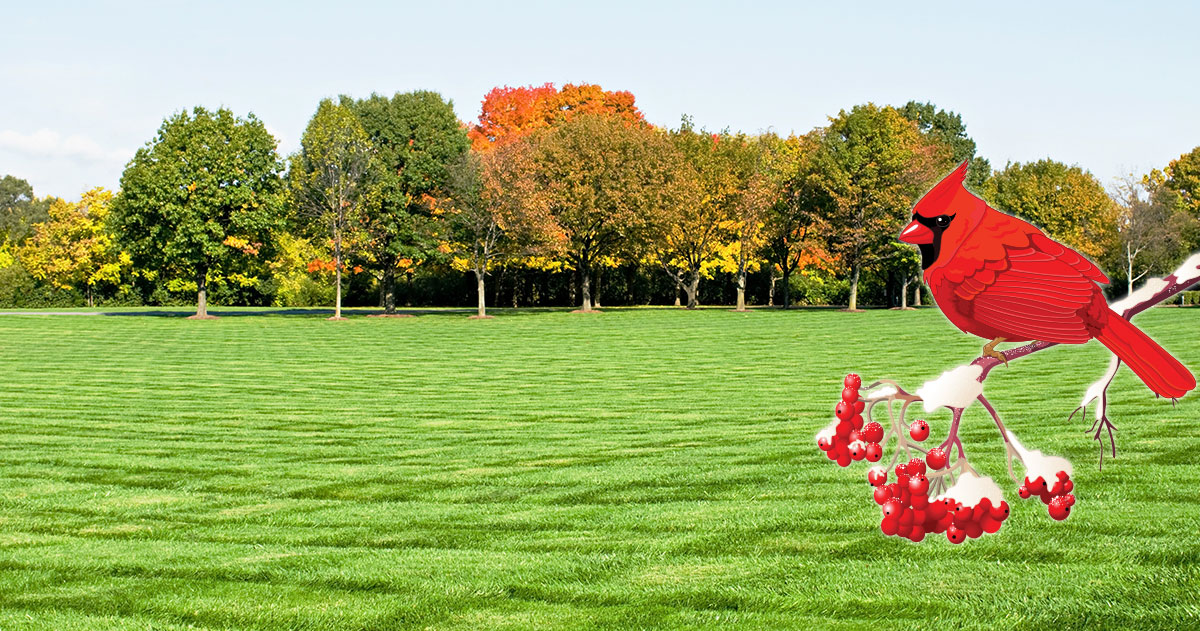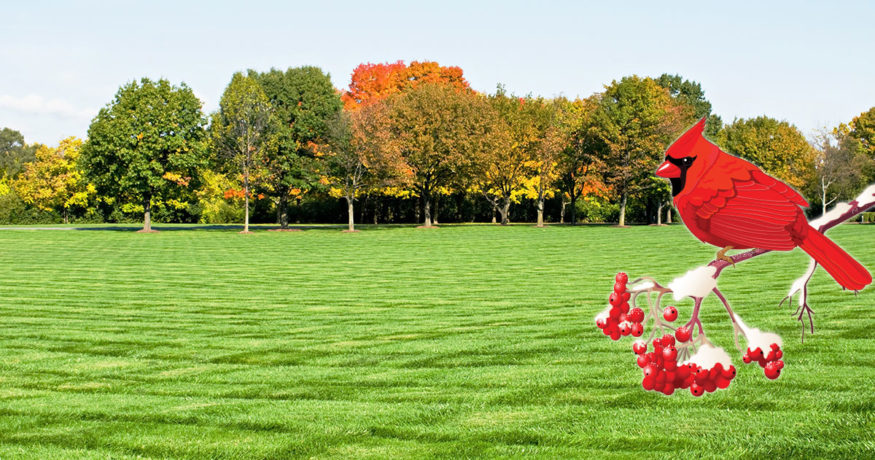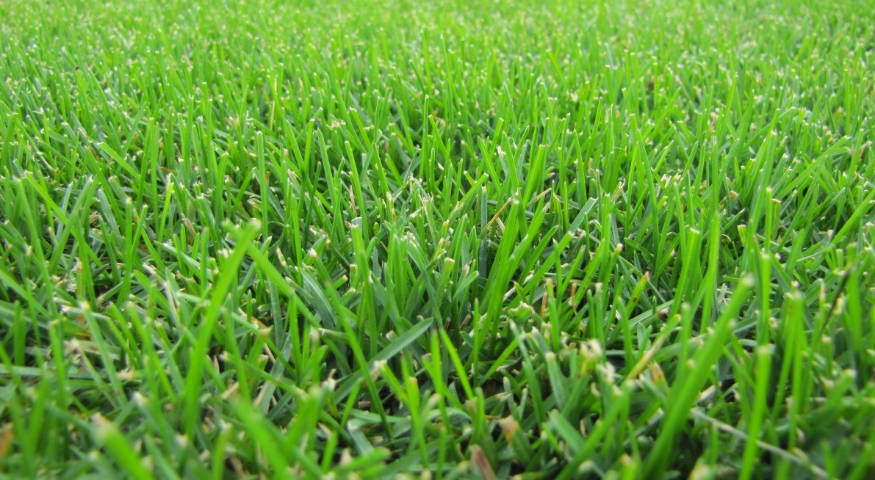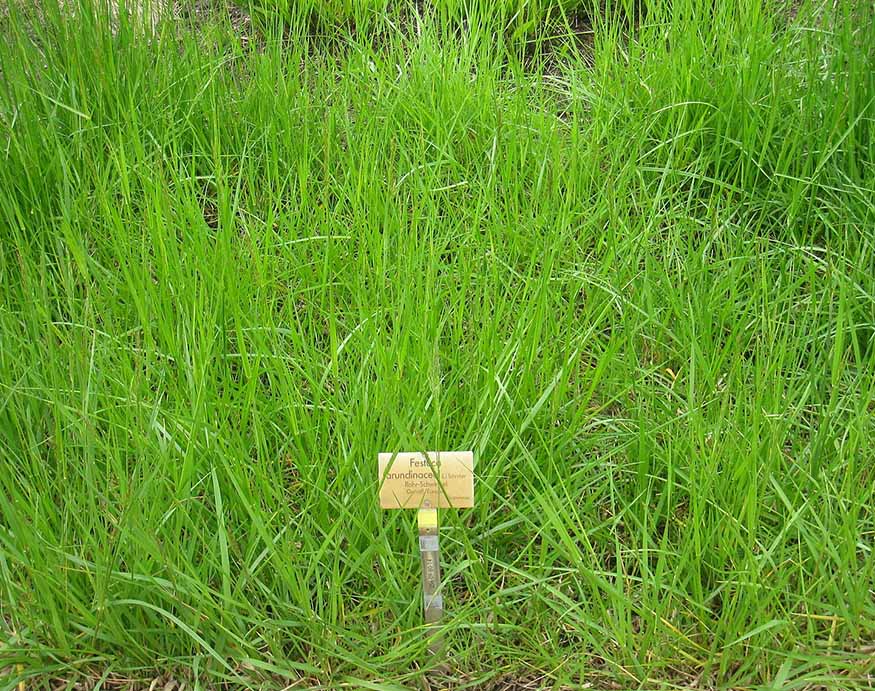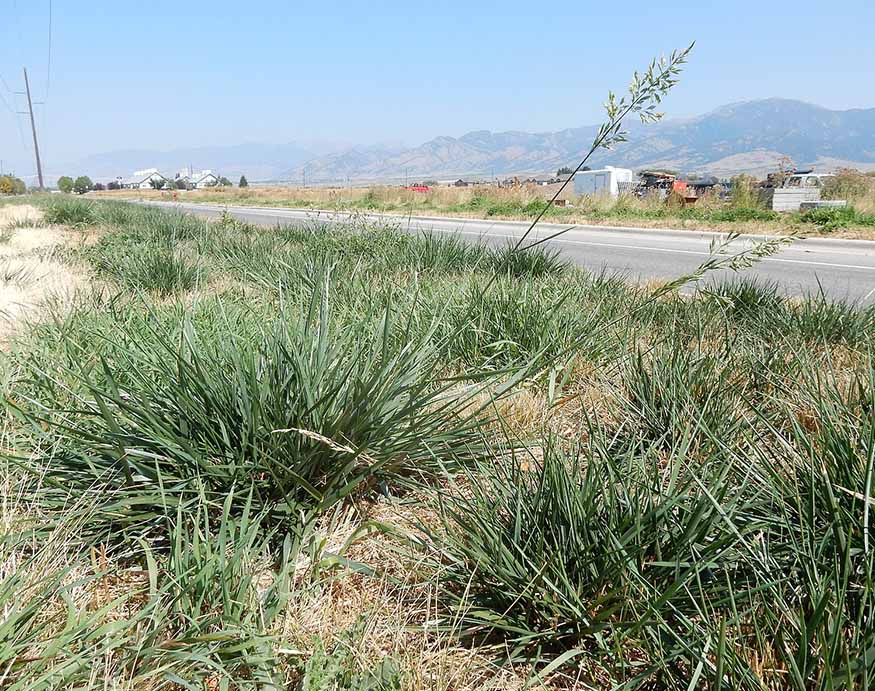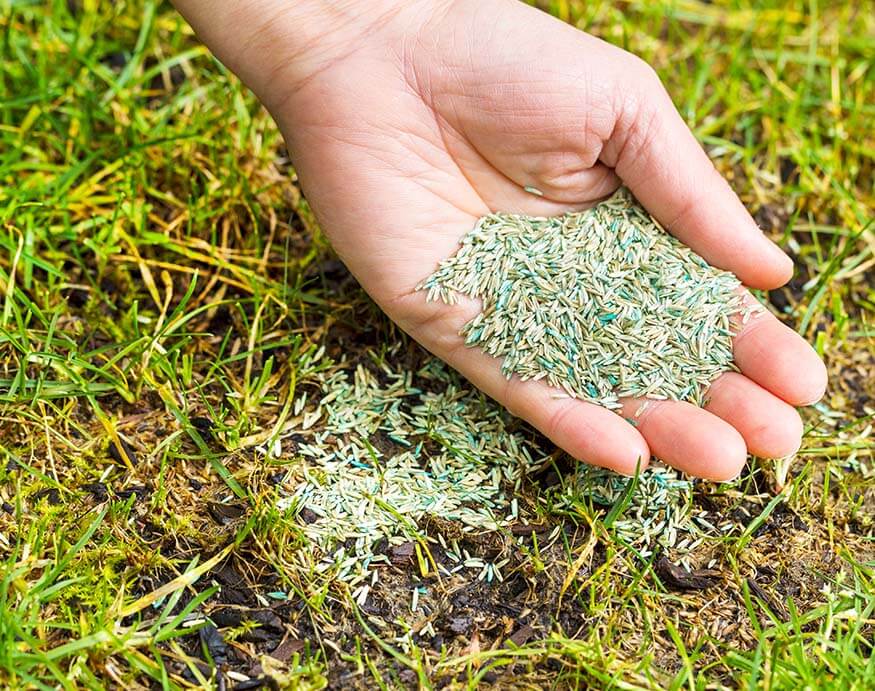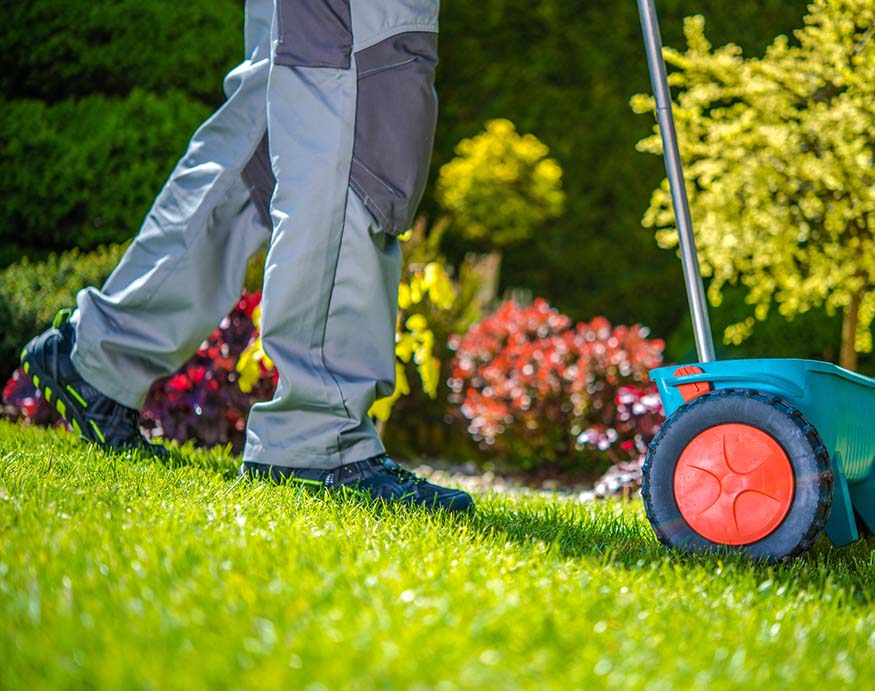Growing a perfect lawn is never easy, but it is possible as long as you choose the right type of grass and understand its maintenance requirements.
So, what is the best grass seed for Ohio?
Cool-season grass varieties like the Kentucky Bluegrass and Perennial Ryegrass are suitable for Ohio’s soil and weather conditions. Of course, these grass species have specific soil and water needs, different seasonal tolerance, germination rates, and appearance.
This guide will help you choose the right grass seed so you can finally achieve the Ohio lawn of your dreams.
The Best Grass Seed for Ohio Lawns
| Kentucky Bluegrass | Fine Fescue | Perennial Ryegrass | Tall Fescue | |
| Appearance | Fine texture | Fine texture | Fine texture | Wider/coarser blade |
| Growing Season | Spring and fall | Spring and fall | Spring and fall | Spring and late summer to early fall |
| Germination | 10-21+ days depending on the season | 5-7 days | 3-5 days | 10-14 days |
| Full Sun/Shade | Full sun | Shade tolerant | Full sun but tolerates partial shade | Shade tolerant |
| Soil Requirements | Well-draining, fertile, neutral pH soil | Tolerant of rocky, sandy, or clay soil, but prefers soil pH of 5.0-6.5 | Well-draining, fertile, neutral pH soil | Tolerant of low-quality soil |
| Water Requirements | Requires heavy summer irrigation | Minimal irrigation | Requires heavy summer irrigation | Minimal irrigation |
| Tolerance | Most cold-tolerant option; moderately heat/drought tolerant only if watered frequently; some varieties are disease-resistant | Very drought and cold tolerant; somewhat disease resistant | Moderately tolerant of heat, cold, drought, disease, and wear and tear | Very heat and drought tolerant |
You can plant any cool-season grass in Ohio, but choosing the right blend for any particular space means you need to understand the differences between the different species. Read on to learn more about the four most common grass types you can grow successfully in your Ohio yard.
1. Kentucky Bluegrass
| Appearance | Fine texture |
| Germination | 10-21+ days |
| Sun/Shade | Full sun strongly preferred; can be mixed with fine fescue in shady areas |
| Soil Requirements | Requires well-draining, fertile, neutral pH soil |
| Water Requirements | Requires heavy summer irrigation |
| Growing Season | Spring and fall |
| Summer Tolerance | Goes dormant without substantial irrigation |
| Winter Tolerance | The most cold-tolerant option |
| Durability/Resilience | Good durability overall. Some varieties are disease-resistant |
Kentucky bluegrass is the most commonly grown grass in Ohio. It is a high-quality fine-textured grass, but at the same time, it is durable and long-lasting. However, it prefers direct sunlight, so if you have shady areas, you will want to mix it with a more shade-tolerant grasslike fine fescue.
Like many types of grass, Kentucky bluegrass grows best in fertile, well-draining soil. It prefers a heavier administration of fertilizer when you plant it and less in subsequent years. Too much fertilizer, especially chemical fertilizer, will burn your Kentucky bluegrass.
For good slow-release fertilizers, check out our round-up of the best organic options for fertilizing your lawn.
Well-draining soil is not optional. If your soil is packed too solid for Kentucky bluegrass roots to penetrate, it makes no difference how well you water and fertilize it. To learn more about tackling this issue, read our guide on how to loosen your compacted soil.
Kentucky bluegrass creates rhizomes, which are like stems that grow horizontally underground. The rhizomes spread out across any open area, putting up new blades of grass and roots. That means Kentucky Bluegrass recovers quickly from damage and will grow to fill in an empty or thin area in your lawn. Most rhizome growth occurs in early summer.
Avoid heavy fertilizing and close mowing in general, but do so during early summer to encourage root and rhizome growth. A minimum 2-inch cutting height is best for encouraging strong growth and excluding invasive grasses.
One of the primary downsides of Kentucky Bluegrass is that it is not particularly tolerant of Ohio summers. It tends to lose color and go dormant. If you aren’t sure if your grass is dead or dormant, check out our guide to identifying and fixing dead and dormant lawns.
Kentucky Bluegrass is not drought tolerant and requires frequent irrigation. To keep it green, you’ll need to provide at least two inches of water per week, no less than one inch at a time (two inches once per week will work if it has an adequate root structure). If you simply want it to remain dormant without dying, watering one inch every 2-3 weeks should be adequate.
2. Fine Fescue
| Appearance | Fine texture |
| Germination | 5-7 days |
| Sun/Shade | Shade tolerant |
| Soil Requirements | Tolerant of rocky, sandy, or clay soil, but prefers good drainage; requires soil pH of 5.0-6.5 |
| Water Requirements | Minimal irrigation |
| Growing Season | Spring and fall |
| Summer Tolerance | Good drought tolerance but can still go dormant. Looks best under 85 Fahrenheit |
| Winter Tolerance | Very cold tolerant, excellent for high elevations |
| Durability/Resilience | Average tolerance of gentle wear, but do not rebound well from damage; somewhat disease resistant, but some are susceptible to red thread, leaf spot, and dollarspot |
Fine fescue is common turfgrass, with fine leaves that grow densely. “Fine fescue” refers not to an individual species but a group of Festuca subspecies. Most are bunching grasses, but one (creeping red fescue) is rhizomatous. However, they have enough in common to discuss them as a group.
Fine fescues are the best cold-season grasses for shady areas. They also mix well with tall fescue or Kentucky bluegrass, for example.
However, this grass germinates quickly but establishes slowly. Sow around September in low elevations or in spring or summer in higher elevations. It can be dormant-seeded in late fall for spring germination.
Fine fescue will tolerate a wide variety of poor soil conditions, including rocky, sandy, and clay soils. It is also very resilient to all but the most extreme environmental stress. However, it is less resilient when it comes to foot traffic or other damage. It will go dormant in extreme heat.
Fine fescue is specifically known for being drought resistant, particularly as young grass. Its drought resistance declines after a few years if you let thatch build up. Thatch changes the texture and color of the lawn. It is easier to remove if you treat it as routine maintenance instead of allowing it to get thick before removing it.
Fine fescue is generally durable, and many varieties can survive close mowing (some golf courses mow it as low as a half-inch). A mowing height of 1.5-2.5 inches works well for the home lawn, but it grows best when left alone to clump. Dull rotary mowers tend to cause brown tips on the cut ends of fine fescue, particularly in summer.
Another major advantage of fine fescue is that it is one of the least environmentally taxing grasses. It is low-maintenance/low-input, meaning that it requires very little watering, fertilization, or pesticides. Fine fescue will eventually turn brown from under-fertilization, but most American lawns are over-fertilized rather than under-fertilized. Avoid fertilizing in the summer. Limit yourself to light applications in late fall or early spring.
3. Perennial Ryegrass
| Appearance | Fine texture |
| Germination | 3-5 days |
| Sun/Shade | Prefers full sun but tolerates partial shade |
| Soil Requirements | Needs well-draining, fertile, neutral pH soil |
| Water Requirements | Heavy summer irrigation |
| Growing Season | Spring and fall |
| Summer Tolerance | Moderate tolerance with heavy irrigation |
| Winter Tolerance | Good |
| Durability/Resilience | Moderate to low disease resistance; very tolerant of wear and tear |
Perennial ryegrass has attractive, shiny, fine-textured, bright green leaves, similar to Kentucky bluegrass. It is clumping grass, not rhizomatic, so it doesn’t tend to spread. In the 1960s, perennial ryegrass was a thin grass that mowed poorly, but modern breeding has transformed it into an attractive and hearty grass.
Perennial ryegrass is extremely durable to wear, so it is commonly used on athletic fields, often mixed with bluegrass. It will tolerate mowing as low as 5/8”. It is very winter-hardy, so one of its most common uses is to overseed turf for better winter color.
Another advantage of perennial ryegrass is its ultra-fast germination rate – the faster your grass seeds germinate, the lower the chances you’ll interrupt germination by forgetting to water.
For more suggestions about how to grow grass fast, check out our guide. Seed perennial ryegrass in the fall unless you’re willing to invest in sod. Expect a fully established turf in 4-8 weeks.
Ryegrass rarely develops severe thatch, but disease can be a problem. Inadequately fertilized ryegrass is susceptible to a wide range of diseases like a red thread, pink patch, crown rust, and brown blight. Over-fertilized ryegrass is prone to fusarium patches and leaf spots. In the winter, it is at risk of snow mold.
Newer cultivars are improved, but you will still need to pay attention to these problems.
Perennial ryegrass is high-maintenance and among the least environmentally sound grasses. It is intolerant of drought. During drought, you may need to water more frequently (1-3 times per week) and deeply (6-12 inches). It will recover quickly from short periods of drought-induced dormancy but will die off with an extended drought. It requires more nitrogen-heavy fertilizer than most grasses, both for strong growth and to maintain disease resilience.
4. Tall Fescue
| Appearance | Wider/coarser blade |
| Germination | 10-14 days |
| Sun/Shade | Shade tolerant |
| Soil Requirements | Tolerates low-quality soil |
| Water Requirements | Minimal |
| Growing Season | Spring and late summer to early fall |
| Summer Tolerance | Good |
| Winter Tolerance | Good |
| Durability/Resilience | Very durable; resilient to pests and disease if not over-fertilized |
Tall fescue is a good low-maintenance alternative to Kentucky bluegrass. It is more tolerant of heat, drought, shade, and wear and tear than other cool-season grasses.
It is a bunching grass with weak rhizomes and can appear clumpy when planted alone, especially if it gets too much foot traffic and not enough water. It has a coarser texture than other grasses, but careful breeding of tall fescue has improved its texture. While it is quite durable, tall fescue will need interseeding every 3-5 years for best results.
This grass benefits from being mowed every 5-6 days instead of seven like Kentucky bluegrass, but it will tolerate infrequent mowing. Mowing it to a height of three inches is best for minimizing weeds. However, some new versions of tall fescue tolerate a shorter height. You will need to remove thatch periodically to prevent buildup.
Tall fescue requires less maintenance and has a lower environmental impact than many kinds of grass. Because of its extensive root system, you may be able to get away with a deep watering once a month during the summer – although more water will produce better quality turf. It also requires only one moderate application of fertilizer in the late fall. Over-fertilizing will contribute to problems with thatch, pests, and disease.
When is the best time to plant grass seed for Ohio?
Regional variation means that Ohio is divided into several USDA growing zones. However, climate change has resulted in a change to the map in recent years. The state is mostly 6A with a little 5B in the mountainous areas and a little 6B on the northern and southern borders.
There are three options for when to plant your seed: fall, winter, and spring.
Fall seeding
The most common time for seeding grass throughout Ohio is mid-August through early October. If it’s a particularly hot year, don’t jump the gun. Keeping the seeds moist while they get established is difficult when it’s too warm out.
Cool-season grasses grow best from 60-75 degrees Fahrenheit. The advantage of sowing around September instead of spring is that the seeds germinate and become established more rapidly with warm days and cool nights. If spring seeds don’t reach maturity quickly enough, they will die when the summer heat arrives.
Winter seeding
Many county extension offices recommend dormant seeding instead of planting during the spring or fall. With dormant seeding, you can plant cool-season grasses in December through mid-March, even when there is snow on the ground. The seeds will remain dormant until the soil temperature rises over 50 degrees Fahrenheit in the spring.
Mimicking nature by allowing the seeds to freeze and thaw (stratification) is good for the seeds, improving germination. For more detailed instructions, check out this guide to dormant seeding grass.
Spring seeding
If it isn’t too cool out, you can overseed cool weather grasses in Ohio from mid-March through early April. The weather conditions are actually good for growing grass around this time (barring a late cold snap), but weeds thrive under the same conditions. Prepare the ground by undercutting before broadcasting seed, but keep in mind that this may create crabgrass problems.
One upside of spring sowing is that keeping the soil moist enough for germination tends to be easier this time of year. However, spring-sowed grass has a weak root structure and requires extra fertilizer and summer irrigation. If it gets too hot out, the grass may not survive. That’s why this is generally not the best time of year for sowing new seed.
How To Grow Grass Seed in Ohio
1. Prep soil
If you haven’t had good luck growing grass in the area you’re seeding before, you may want to get a soil test first.
Testing gives you important information about your soil’s pH level, nitrogen content, and other factors. Check your state’s Extension Office for a recommendation for a good lab in your region. You’ll mail the lab a bag of soil, and they’ll send you a report on its contents with specific recommendations for soil amendments, often for as little as $20. This is much more accurate than home soil testing kits.
Prepare the soil by removing existing plant matter, rocks, and debris to a depth of 6 inches. Break up and aerate the soil if needed. Mix in compost, fertilizer, and other amendments. Then level the surface.
2. Sow Seed
Unless you are over-planting or interplanting a small area, you should use a seed spreader for uniform distribution in large areas. Sow at the rate indicated by the package of seed, based on the particular blend.
3. Cover
Lightly rake the area to cover the seeds with soil. You can use a lawn roller to tamp down the area, which will minimize erosion and birds eating the seed. Cover the area with a fine mulch (such as a thin layer of peat moss, grass clippings, or straw) to hold the seeds in place.
4. Keep it moist
Soak the area with 4-6 inches of water immediately after sowing. Be gentle, so you don’t wash away the seeds and ruin your even distribution. A hand-sprayer with a misting option is ideal.
You must water the seedlings at least once a day and sometimes as often as 3-4 times daily if it is warm out. Water until the seeds are well established (at least a half-inch high). If you stop watering at any point during germination, the seeds can dry out and die.
Daily watering can take a minimum of 7-14 days and sometimes as long as a month.
If your grass is spotty or thin due to germination or distribution problems, check out our guide to overseeding.
Choose The Best Grass For Ohio
If growing a beautiful lawn was easy, everyone would do it. It requires some work, but you’ll have a major advantage if you choose the right seed for the right location. Whether your primary concern is leaf quality, minimizing maintenance, or environmental impact, there are great options for growing your ideal grass in Ohio.
